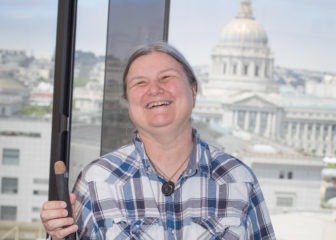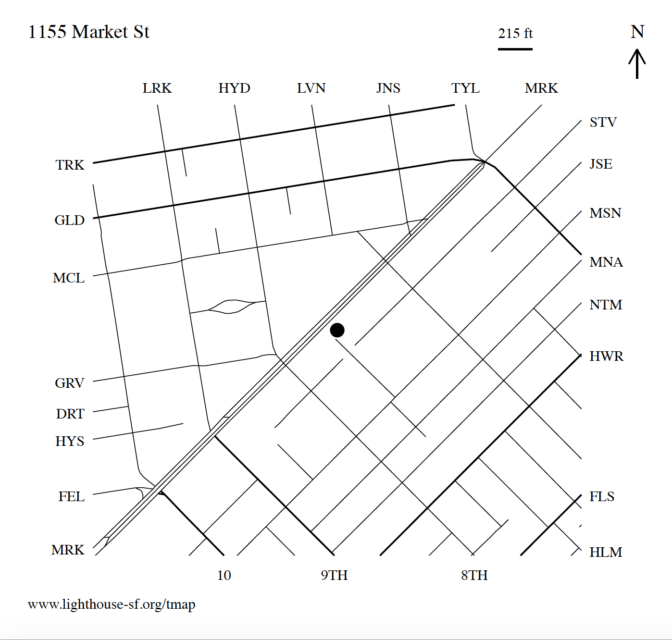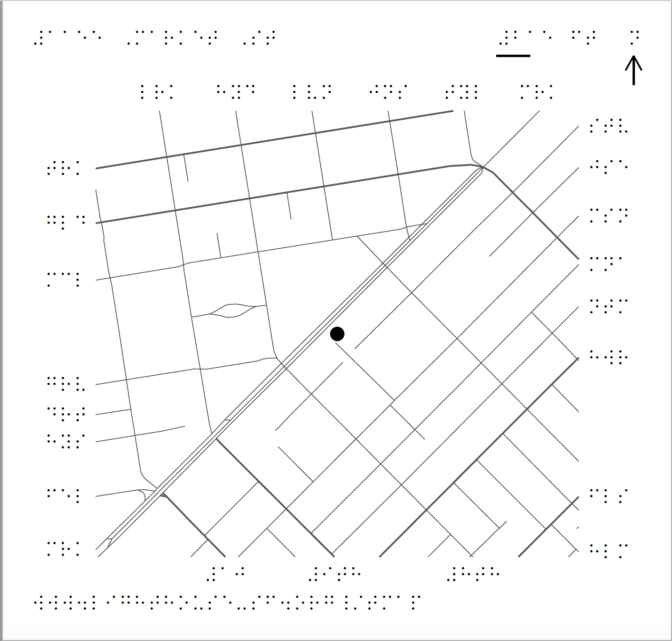In January, LightHouse started offering TMAP — on-demand tactile street maps — for order at our Adaptations Store (1-888-400-8933). We have been hearing some amazing stories about how our maps are being used, so we wanted to share them with our mapping community. Order yours today by calling 1-888-400-8933.
When Sheri Wells-Jensen was a child, she got one book per week. That was how it worked, for a blind kid – a braille reader – who relied on braille lending libraries. Each week, Sheri would bound out of her front door, crashing through her front yard and into the mailman’s truck, to get her hands on one new book. Now a linguistics professor at Bowling Green State University, access to language and information has become a passion of Sheri’s, as well as other cool things like aliens and ukuleles.
 She also loves exploring cities. Depending on how you see it, Market Street in San Francisco can feel like a boulevard of first-world efficiency or a medieval circus. At times, it feels like both at once. This wild, eclectic fusion can be intimidating for some, but this crazy hubbub is what Sheri loves most about visiting the city by the bay. On a recent trip, we had the pleasure of printing out her first-ever TMAP.
She also loves exploring cities. Depending on how you see it, Market Street in San Francisco can feel like a boulevard of first-world efficiency or a medieval circus. At times, it feels like both at once. This wild, eclectic fusion can be intimidating for some, but this crazy hubbub is what Sheri loves most about visiting the city by the bay. On a recent trip, we had the pleasure of printing out her first-ever TMAP.
It was right before she was taking off to catch the bus back to her hotel. The bus stop was a few blocks away and Sheri, her own most cheerful but fierce advocate, exclaimed when we told her we had a tool to help her learn the neighborhood in just a few minutes – and that it was something she could bring with her, should she get lost or just want to explore.


“Having an accurate,accessible,hard copy map to explore saves endless frustration,” Sheri says. “It changes the rules of the game: without the map, I get directions and learn a route, hoping to fill in details later on. With the map, I learn the neighborhood and then decide how I want to get to my destination.”
Holding her TMAP in front of her, pressed against her torso as she inspected the braille labels and learned the many swerving diagonals of the area, it was impossible not to feel the infectious sense of satisfaction that comes from unlocking so much knowledge with such ease – especially for a kid who grew up on only one book at a time.
As Sheri sees it, maps and tactile aids are a crucial tool for anyone who needs access to information. And when she wants to learn an area, she thinks it’s better than talking. “I basically have two choices,” she explains. “I can sit some poor unsuspecting fellow down and grill him relentlessly about every intersection and every street name (most of which he won’t remember) – or – with a map in my hands, I can transfer the whole picture of the area straight into my head, thereby saving time and preserving my friendships.”
You can listen to Sheri talk about braille love letters and why braille is worth fighting for in a recent episode of The World in Words on PRI, entitled “Will blind people use Braille in the future?”.
Get your TMAP today
To order a map, call our product specialists at 1-888-400-8933 and specify the street address of the map you’re interested in receiving. Within two business days we’ll ship you your map, or make it available for pick up at the Adaptations Store (1155 Market St., 10th Floor, San Francisco, CA). Each TMAP package is $19.99 per address.
What’s in the package?
- You will receive 3 map versions printed at simple, moderate and dense map scale ratios
- A tactile map key
- An introductory page
- All materials are printed on 11” X 11.5” sheets of embossed paper and include ink / large print labels in addition to braille
Click here to learn more more about TMAP.
